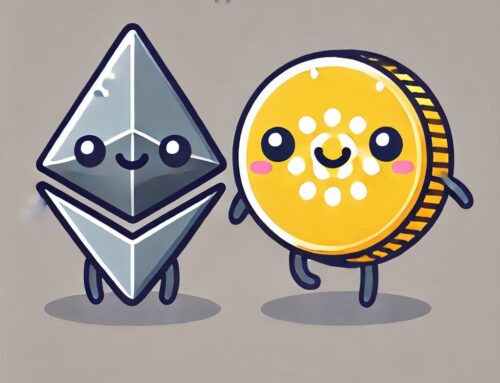Introduction to Crypto: Digital Money That’s More Than Just a Fad (Probably!)
You’ve probably heard the buzzwords: Bitcoin, Ethereum, Cardano… it’s like a whole new language, spoken mostly by people who spend a lot of time on the internet (and maybe a few of your weird uncles). But what are these mysterious digital currencies, and how do they actually work? Are they the future of money, or just a flash in the pan, like those pet rocks you begged your parents for? Well, let’s embark on a journey into the world of crypto, exploring all its wonders, mysteries, and a few of the pitfalls, all while keeping it simple.
What Exactly Is a Cryptocurrency, and Why Should You Care?
First things first, let’s get down to brass tacks and define what a cryptocurrency actually is. In the simplest terms, a cryptocurrency is a digital or virtual currency that uses cryptography for security. Think of it like digital cash, but without the physical coins or paper bills – it’s like trading Pokemon cards, but those cards can be traded for real money (or other digital assets). Unlike traditional currencies issued by central banks, cryptocurrencies are typically decentralized, meaning they aren’t controlled by a single entity. This decentralization is what makes crypto so revolutionary and also so confusing to people who have been using traditional banking systems their whole lives.
Key Characteristics of Cryptocurrencies: The Quirks and Perks
Let’s break down some of the key characteristics of cryptocurrencies, that make it unique:
-
Digital (Duh!): They exist only in digital form. There are no physical coins or bills that you can hold in your hand; it’s like a ghost, that can only be seen on a computer screen (but it can still be used to buy real things). This digital-only nature is a key feature of crypto, making it different from the fiat currencies we are used to.
-
Decentralized (No Bosses!): Most cryptocurrencies are not controlled by a single institution, like a bank or government (unlike traditional money, where a group of people in fancy suits control the flow of capital). Instead, they are managed by a network of computers. This means no single entity has complete control over the network, which reduces the risk of manipulation and censorship. This decentralization is one of the core ideas behind the crypto revolution.
-
Secure (Thanks, Cryptography!): Cryptography (the fancy word for secret code) is used to secure transactions and control the creation of new units of currency. This makes it very difficult (though not impossible) for anyone to tamper with or counterfeit crypto. It’s like having a super-secure lock on all of your digital transactions, protecting them from hackers and other nefarious individuals.
-
Transparent (But Kinda Anonymous!): All transactions on a blockchain, the technology that supports crypto, are recorded on a public ledger. This means that anyone can see the flow of crypto, but the identities of the users are usually obscured (not completely hidden, but at least more private than some other types of transactions), which provides a level of anonymity and privacy. This unique blend of transparency and anonymity makes crypto quite fascinating.
How Does Crypto Actually Work?
Okay, so they’re digital, decentralized, secure, and transparent. But how does all of this actually work? It’s not as complicated as it might seem, so let’s break it down into some simple steps:
-
Transactions (The “I’m Sending You Money” Part): When you want to send crypto to someone, you initiate a transaction. It’s like sending a digital IOU note. This transaction is like saying, “I want to send Bob 5 digital coins,” with all the details of this transaction being recorded in the blockchain.
-
Broadcast (The “Hey Everyone, Look At This” Part): Your transaction is then broadcast to the crypto network, meaning all (or at least, a lot of) the computers on the network see this pending transaction. It’s like shouting your transaction to the world, making everyone aware of what’s about to happen.
-
Verification (The “Is This Real?” Part): Computers on the network, often called miners or validators, verify the transaction. They use complex algorithms to ensure that the sender has the required funds and that the transaction is legit. This is like the bank checking if you have enough money to cover a check. This verification process is a key part of how crypto works.
-
Block Creation (The “Let’s Make It Official” Part): Once verified, the transaction is bundled with other verified transactions into a new “block” that’s added to the blockchain, creating a permanent record of all the transactions that were recently processed.
-
Blockchain Update (The “Let’s Update the Record Books” Part): All computers on the network update their copy of the blockchain with the new block, permanently recording the transaction for posterity.
And just like that, the transaction is officially recorded on the blockchain. It’s permanent and virtually impossible to alter. It’s like writing a new chapter in a history book, where the previous chapters are set in stone. This process might seem a bit complicated, but it happens incredibly fast (almost like magic!), with most transactions being completed within minutes.
The Role of the Blockchain: The Heart of Crypto
As we touched on earlier, the blockchain is the heart of any cryptocurrency. It’s a public, distributed ledger that records all transactions.
Imagine this: Think of a giant, shared spreadsheet that everyone on the network has a copy of. When a transaction occurs, it’s added as a new row to the spreadsheet. Because everyone has a copy, it’s nearly impossible for anyone to tamper with the data, which is why it’s such a secure system. This is why blockchain is the underlying technology behind almost all crypto applications.
What is Mining and Validation? (The “Who Does All the Work?” Part)
You might have heard of “mining” in the context of cryptocurrencies. This is the process by which new transactions are verified and added to the blockchain, and sometimes, the creation of new units of the crypto.
-
Think of it like this: Imagine that the computers on the network are constantly competing to solve complex puzzles. When a computer solves a puzzle, it validates the latest transactions and gets rewarded with a small amount of the cryptocurrency. It’s like a digital scavenger hunt where the prize is more crypto. This helps keep the network secure and running smoothly, as there are incentives for people to maintain the system.
-
Different methods: Some cryptocurrencies use “Proof of Work” (like Bitcoin), which involves heavy computation, while others use “Proof of Stake” (like Cardano), which involves holding a certain amount of the crypto to become a validator. These different methods allow for different approaches to maintaining the blockchain.
Why Are Cryptocurrencies So Popular? (The “Why All the Hype?” Part)
Now you might be wondering, why bother with crypto at all? Here are a few reasons why they’ve gained so much popularity (and a little bit of notoriety):
-
Decentralization (No More Bank Fees!): Many people like the idea of a currency that isn’t controlled by a single bank or government, giving more power to the users. It’s like having your own private vault, without needing the bank’s permission to access your assets. This decentralization is a major part of the crypto movement.
-
Security (It’s Kinda Like a Fortress!): Cryptography makes it very difficult to counterfeit or manipulate transactions, which provides a high level of security for crypto assets. It’s like having an unbreakable code that protects your digital funds.
-
Global Access (Money Without Borders!): Cryptocurrencies can be used anywhere in the world, making international transactions easier, cheaper, and faster than traditional banking methods. It’s like having a universal currency that can be used anywhere in the world.
-
Innovation (A New Era of Finance!): The technology behind cryptocurrencies is seen as a significant innovation that could have far-reaching impacts across various industries, making the technology an area of intense interest. This potential for innovation is a major factor behind the interest in crypto technologies.
-
Potential for Investment (To the Moon!): Some people invest in cryptocurrencies with the hope that they will increase in value. However, it is very important to understand that investing in crypto is very risky, and it is possible to lose money!
The Risks of Cryptocurrencies (Not All Sunshine and Rainbows!)
It’s also important to remember that cryptocurrencies aren’t without risks (nothing is perfect, after all):
-
Volatility (Up, Down, All Around!): Prices can fluctuate wildly, so your investment could lose value quickly. Investing in crypto is always risky, and it is possible to lose money! It’s like riding a roller coaster, where the ups and downs can be quite unpredictable.
-
Security Risks (Hackers Are Always Lurking!): While blockchain technology itself is secure, exchanges and wallets can be vulnerable to hacking. It’s like having a strong safe, but the building itself might have weak doors.
-
Lack of Regulation (The Wild West of Finance!): The regulatory landscape for cryptocurrencies is still developing, which can lead to uncertainty. It’s like navigating a new frontier where the rules are still being written.
Different Types of Cryptocurrencies (It’s Not Just Bitcoin!)
While Bitcoin was the first cryptocurrency, there are now thousands of different options. Here are a few examples:
-
Bitcoin (BTC): The original and most well-known cryptocurrency. It’s like the grandaddy of all digital coins, that paved the way for others.
-
Cardano (ADA): A blockchain platform with a focus on sustainability and scalability for creating decentralized applications (dApps) and smart contracts, as well as its own cryptocurrency.
-
Stablecoins (USDC, USDT): These are designed to maintain a stable value relative to another asset, like the US dollar. It’s like having a digital currency that tries to be a bit more steady, when compared to the volatility of other crypto options.
The Takeaway: The World of Crypto is Here to Stay (So, Learn About It!)
Cryptocurrencies are digital forms of money that use cryptography for security and operate on decentralized networks. They offer a fascinating glimpse into the future of finance, but they also come with risks. Whether you’re looking to invest, experiment with the technology, or simply learn more about the world of digital currencies, it’s important to understand how they work. So, while the world of crypto might still seem a little weird and confusing, remember that even the most revolutionary things start with a single, weirdly-shaped block. And now that you have the basics down, it’s time to dive deeper into this fascinating and ever-evolving landscape!





